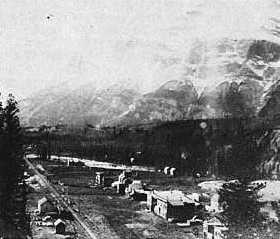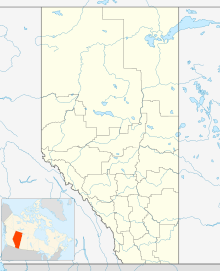Anthracite, Alberta facts for kids
Quick facts for kids
Anthracite
|
|
|---|---|

The mine site (foreground) and the townsite (background left) of Anthracite in 1895
|
|
| Country | Canada |
| Province | Alberta |
| Improvement district | ID No. 9 (Banff) |
| Government | |
| • Type | Unincorporated |
| Time zone | UTC−7 (MST) |
| • Summer (DST) | UTC−6 (MDT) |
| Area codes | 403, 587, 825 |
Anthracite is a ghost town located inside Banff National Park in southern Alberta, Canada. A ghost town is a place where people used to live and work, but now it's mostly empty. This town was named after a type of coal called anthracite, which is a very hard and shiny kind of coal.
Contents
A Town Built on Coal
Anthracite was an active town from 1886 to 1904. During this time, a company called the Canadian Anthracite Coal Company mined a lot of coal nearby. This area is now part of Banff National Park, which is a special place recognized by the United Nations as a World Heritage Site.
How Anthracite Started
Anthracite was one of many small towns that grew up around the construction of the Canadian Pacific Railway. Workers building the railway accidentally found some hot springs in nearby Banff. This discovery helped bring more people to the area.
By 1887, the town of Anthracite had about 300 people. Most of the residents came from the eastern United States. The town had a few important businesses. These included a general store, a hardware store, a hotel, a pool hall, a restaurant, and a barber shop.
Mining Challenges and Closure
The coal mine faced many problems. Because of these difficulties, the Canadian Anthracite Coal Company closed the mine in 1890. However, it reopened the very next year. A person named W. H. McNeill agreed to help pay for the coal company's operations.
But the mine continued to have bad luck. There were a series of floods and other issues. Eventually, McNeill decided to move his mining work to a different town nearby called Canmore. Anthracite was left empty by 1904. Later, in the 1930s, the Canadian government made it illegal to mine in that region.
What's Left Today?
In 1997, a former employee of Parks Canada named John Pearson shared an interesting story. He was the last person known to have lived in Anthracite. He told a Banff newspaper about a rumor he heard in the 1960s. The rumor was that a child had drowned in the nearby Cascade River in 1883. People believed the child's body was buried somewhere in the Anthracite area.
After this story came out, the government started an investigation. They looked into the rumor and decided it was likely true that there was an unmarked grave in the community. To remember the child, they placed a special plaque at the burial site.


